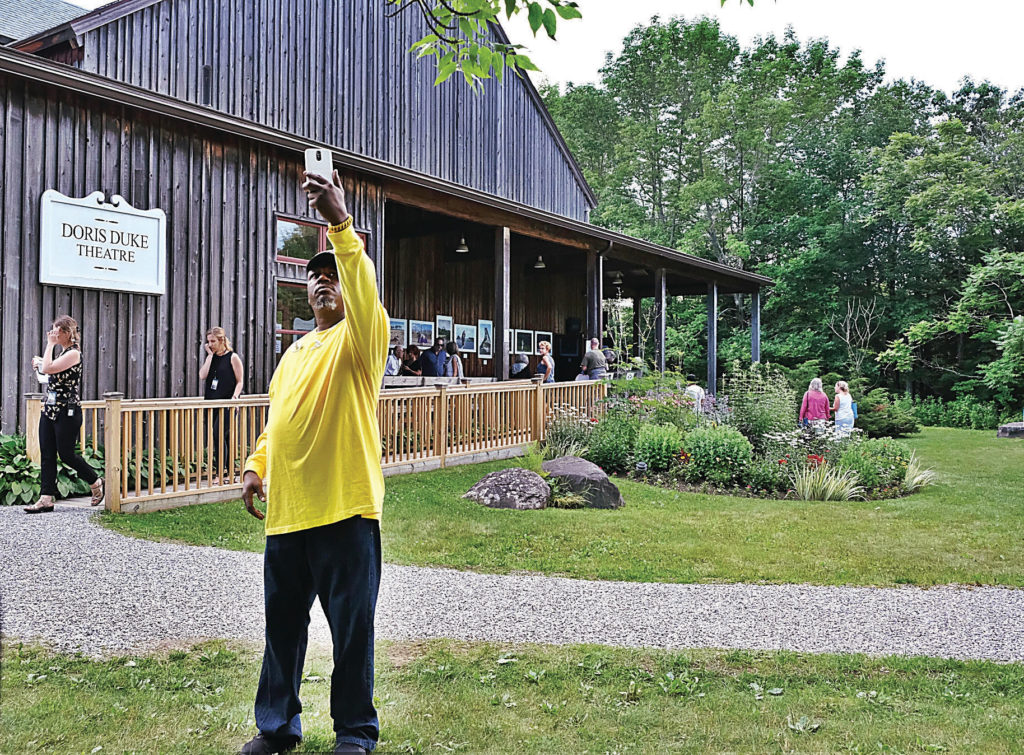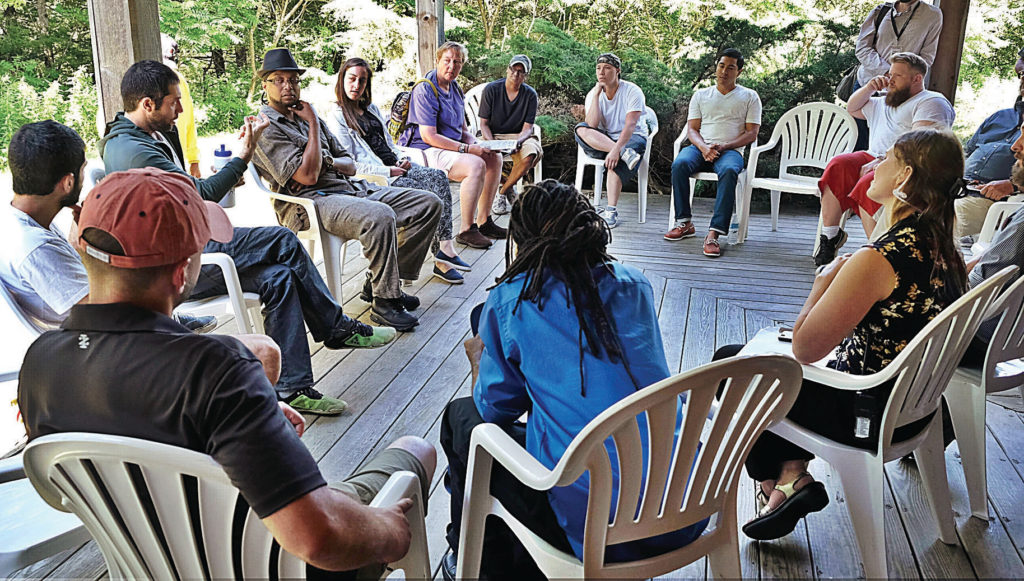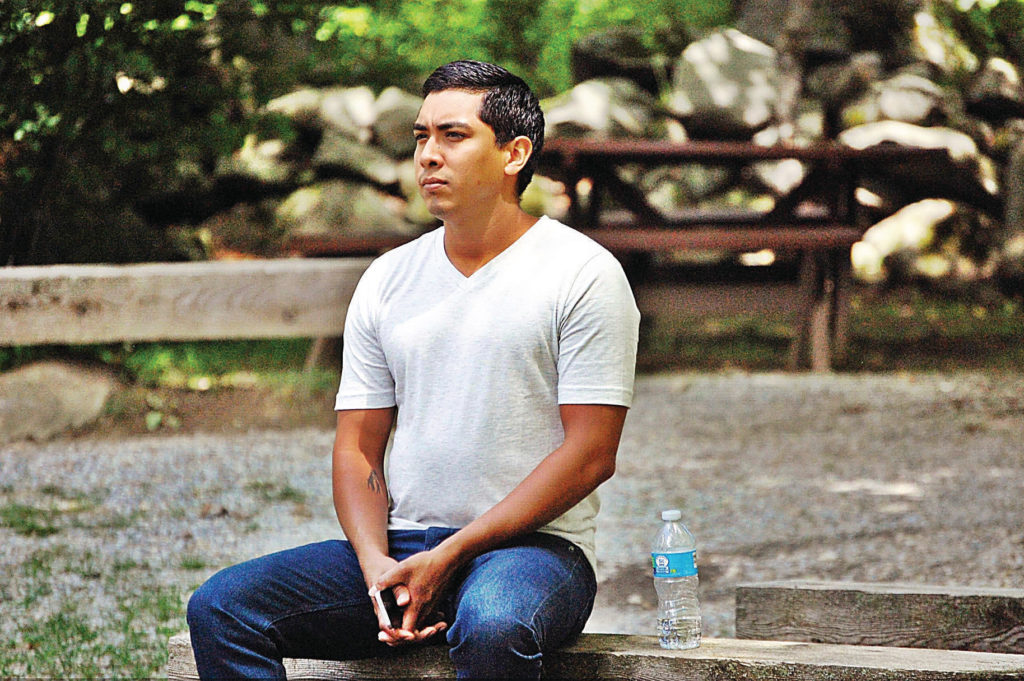The Berkshire Eagle: A Partnership with Jacob’s Pillow
A delicate dance: Veterans captivated, unharmed by Pillow
By Benjamin Cassidy
Larry, a U.S. Marines veteran, had just watched Roy Assaf Dance perform a duet exploring an intimate relationship between a man and a woman at the Jacob’s Pillow Dance Festival.
The veteran’s name has been changed in this story to protect his identity per his request due to concerns for his family.
Four hours earlier, he was lingering alone outside Soldier On’s Pittsfield office, waiting for the van that would take him to the Becket institution. On a warm Saturday morning in July, he was wearing a black suit jacket and jeans, a white shirt with black stripes, gray-rimmed sunglasses and a U2 pin on one of his lapels, exhibiting the aura of an arts scene regular. His attire and posture — chin lifted, back straight — contrasted starkly with the men slouching silently in a waiting room inside just a few minutes earlier, the front desk unattended, a smoky stillness presiding.
“Modern dance is very cool,” Larry told me as he waited.
As a Berkshire County resident his entire life (he’s now in his late 50s), he had long held an appreciation for Jacob’s Pillow. Yet, he had never visited the site.
“It wasn’t, like, my thing,” Larry said.
On two consecutive July weekends, Soldier On and Jacob’s Pillow tried to combat this feeling by bringing homeless veterans to the dance center to tour the grounds and take in military-themed performances. On July 8 and 9, groups watched Jessica Lang Dance explore military loss in “Thousand Yard Stare,” and on this day, the veterans would be watching Roy Assaf Dance. In addition to the duet, “Six Years Later,” the Israeli company would be performing “The Hill,” an all-male trio about the Six-Day War’s Givat Hatachmoshet, or Ammunition Hill, battle in Jerusalem.
“We thought [the content] might really resonate with the veterans’ experience,” said Thasia Giles, director of community engagement at Jacob’s Pillow, during a telephone interview.
Before the previous weekend’s visit, Soldier On case manager and artist-in-residence Nathan Hanford said he hadn’t expected the veterans to speak positively about the experience upon returning to their sites. He thought they would fear ridicule for expressing interest in the arts. To Hanford’s surprise, however, the groups were “glowing,” he said, encouraging other veterans to sign up for next week’s trip.
Larry was one of the new recruits, though he wasn’t a tough draw. His mother used to tell him he was a doctor’s baby because his tastes mirrored those of the affluent.
“I always appreciated the finer things,” he said.
But to say Larry’s current crowd doesn’t have such deep pockets would be a drastic understatement. Larry lives in one of Soldier On’s 39 permanent housing units designated for homeless veterans across the parking lot from the main building, which holds a kitchen, gym and transitional housing. Veterans pay rent through Section 8 and the U.S. Department of Housing and Urban Development’s Veterans Affairs Supportive Housing (HUD-VASH) subsidies, according to Soldier On director of communications Casey DiCicco. The organization also has 87 permanent units in other locations — 44 in Northampton and 43 in Chicopee — and is developing 51 more in Agawam.
Eight veterans from the Northampton site were scheduled to meet with six more from Pittsfield on this Saturday, but a few from Pittsfield were unable to attend, leaving driver Steven Jette (a veteran and Soldier On member himself), E.J. Schlup and Larry. When Jette arrived, I took one of the empty seats.
Larry soon began telling the story of how he became homeless. Following his stint in the Marines, Larry worked in a local hospital. He was married with two daughters.
“I was a regular Joe,” he said.
But then health problems cropped up — diabetes and hepatitis C, he said.
Doctors put him on Interferon to treat his hepatitis C, but a vicious reaction to the medicine ensued, he said, rolling up a pant leg to display the scaly, dark scars it left behind. To fight the pain, a doctor prescribed fentanyl, but that was too strong for Larry.
“And then the doctor said the magic words,” Larry recalled, “‘Have you ever heard of OxyContin?'”
The pain medication is highly addictive and has played a significant role in the nation’s opioid epidemic.
“It just takes you over,” Larry said.
He quickly became addicted to the drug and soon found himself using others. Additionally, his marriage had fallen apart due to his “shenanigans.” When his girlfriend grew tired of them, too, he had nowhere to go and was too proud to ask his daughters for money. He was homeless for about a month, he estimated, before finding Soldier On.
I changed the subject, addressing what Hanford had raised a few days earlier: Was attending a modern dance performance viewed as an affront to masculinity in the veteran community?
“That’s a good question,” Schlup responded instead, swiveling in the passenger seat. He arrived at Soldier On in June, staying in Pittsfield’s transitional housing as he continues to deal with complications from a severe stroke he suffered in 2015. Though he was dressed more modestly (blue jeans, T-shirt, Nikes) than Larry, Schlup knew the terrain they were about to traverse much better. For more than a decade, he and his wife, Diana, visited Jacob’s Pillow regularly while they were living in New York state. The dancers enthralled Schlup, particularly the women (“it’s amazing the devotion and focus it takes”), but he said American men’s egos don’t often allow for this appreciation of female independence.
“A lot of guys would be terribly intimidated by this,” he said.
Intimidation isn’t the first feeling that Jacob’s Pillow spectators usually experience upon entering the campus. Nestled deep in the Becket woods, the dance center’s scenic grounds are naturally inviting, and on this sunny Saturday, with children playing in fields, dancers eating lunch among their admirers and light beaming through the trees, the area even acquired an enchanting, communal quality.
But there was some unmistakable tension when we arrived. After facilities coordinator Jay Lopez, a veteran himself, waved us into the parking lot, we met up with Giles, fellow community engagement staffer Ivy Kuhn and Hanford on the center’s main pathway. Giles and Kuhn began outlining the plan for the day (tour, lunch, performance), but Hanford looked concerned.
“[I’m] not in contact yet with Leeds,” Hanford said, referring to the larger group making the trek from Northampton.
In the ensuing moments, Giles tried to override this disquiet, asking Schlup, who visited the previous weekend, how he was doing.
“I’m trying to keep my brain from shorting out,” Schlup answered, referencing his ongoing neurological problems.
Seven men from Leeds arrived shortly thereafter, bringing energy to our languishing group. They greeted everybody around the circle, offering handshakes and hugs. One of them, Gilbert Carr, quickly began a long afternoon of phone documentation, snapping selfies and shooting videos.

NINA COCHRAN – THE BERKSHIRE EAGLE
Gilbert Carr taking a selfie in front of the Doris Duke Theatre, where the group saw performances of Roy Assaf’s “Six Years Later” and “The Hill.” Becket, Mass. July 15, 2017.
Kuhn started the tour by leading us to a boulder behind the Hunter House: It was Pillow Rock, one of the inspirations for the site’s naming. After the group posed for a photo, I walked with Isaac Paul, a U.S. Army veteran, to The Ben & Estelle Sommers Studio. He had attended a session last week, too. “I’ve never had any attention like that,” he said.
Inside the studio, it was hot, leading to some questions about air conditioning. Nope.
“It’s no different than our barracks,” Lopez said. He explained that dancers’ preparations are as intense as soldiers’. Lopez has had both experiences, taking up the art after his time in the Marines. When he informed his platoon sergeants and lieutenants of his plans after the military, they began calling him “Corporal Twinkle-Toes.”
“I was a bit of the running joke,” Lopez recalled during a subsequent telephone interview, though he says his fellow Marines have since watched him perform.
The veterans certainly appreciated Lopez’s unofficial role as bridge between military and dance, but they hardly needed it. The group asked questions and studied their surroundings intently throughout the tour, which included stops at the Ruth St. Denis Studio (Hanford’s “church” during his decade-plus stint at the festival) and the center’s archives.
During lunch, I sat with Carr and Ernest Hughey, a 31-year-old U.S. Army veteran who has spent time in jail since his service. He joined Soldier On in 2015 and was thrilled to be visiting Jacob’s Pillow because of his own passion for the art form. “I just watched Michael Jackson,” Hughey said of his early dance influences.
Hughey was particularly struck by the famed Inside/Out Stage, where the group congregated after lunch before proceeding to the Doris Duke Theatre for the afternoon’s main event.
“It’s been terribly enjoyable,” Schlup reflected before the performance.
With aggressive movements and familiar material, however, the dances presented an opportunity to trigger troubling memories and even re-traumatize (the U.S. Department of Veteran Affairs estimates that 10-30 percent of veterans of the U.S. wars in Vietnam, Iraq and Afghanistan have experienced post-traumatic stress disorder, though these numbers are based on representative samples rather than concrete figures). Giles and Hanford attempted to plan every detail of the day, such as the group’s seating position (the third-to-last row) at the dance, accordingly. (Three female Soldier On members also toured the grounds, but they were mostly kept separate from the men due to the prevalence of sexual trauma in the military, according to DiCicco.)
“If any of you guys feel like it’s too much, you should feel free to exit the theater,” Hanford told the huddled male group outside the venue.
Still, the veterans encountered some difficulties. In “Six Years Later,” a prolonged period of inactivity preceded the duet, which made veteran Anthony Stirlacci anxious. He was worried something had gone wrong. “Some stuff we can take. Some stuff we can’t,” he said during the intermission. Stirlacci also cited the theater’s darkness as a concern; the previous week had been brighter, he said.
The next composition, “The Hill,” had more potential to trigger, with depictions of death and struggle. At one point, a dancer heaves a fallen one over his shoulder. But the show was mostly harmless, according to many of the veterans. One oversight was the use of a sparkler near the front of the stage. From the veterans’ position near the top of the bleachers, it was difficult to see what was happening. “I was just hoping it didn’t blow up,” Lewis Gomez said later, before adding that the incident didn’t impact him much. He was one of many in the group who preferred the first dance.
“The hands were so cool,” Stephen Cook said of some particularly nuanced movements during “Six Years Later.”
After “The Hill,” Hughey was one of the first in the theater to stand.
“I wanted to see more,” he told me as we descended the stairs. Minutes later, he was hugging Assaf, who met with the veterans outside the theater for a question-and-answer session about his time serving in Israel’s military and its influence on his work. “It was not my intention to make a piece about combat,” he explained.

NINA COCHRAN – THE BERKSHIRE EAGLE
U.S. veterans in discussion with Roy Assaf and Avshalom Latucha at the Doris Duke Theatre at Jacob’s Pillow. Becket, Mass. July 15, 2017.
“Mission-focused,” Schlup said of Assaf’s performance after we piled back into the van heading to Pittsfield.
Earlier, Larry had offered a more general reflection on the day. “I think I found my new hangout,” he said.
Though Schlup and Larry clearly appreciated the afternoon, I pressed them on the potential for the show to re-traumatize others. Larry mostly kept quiet. Schlup stressed that it’s impossible to account for all potential pitfalls.
“There’s different triggers for different people,” Schlup said, noting that they can range from a dog barking to the smell of jet fuel.
Schlup’s father, for instance, had been in the military and could easily spiral downward. “You were always dancing in a minefield when you were around him,” Schlup said.
For one day, at least, Soldier On members could enjoy their own dances.

NINA COCHRAN – THE BERKSHIRE EAGLE
Lewis Gomez at the public dance rehearsal on the outdoor Inside/Out stage at Jacob’s Pillow. Becket, Mass. July 15, 2017.


